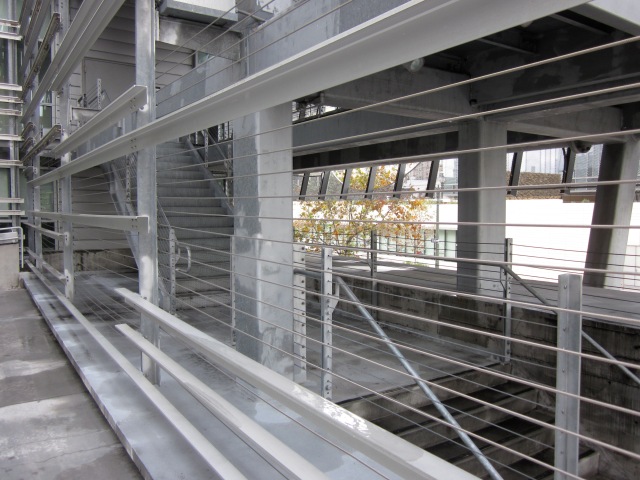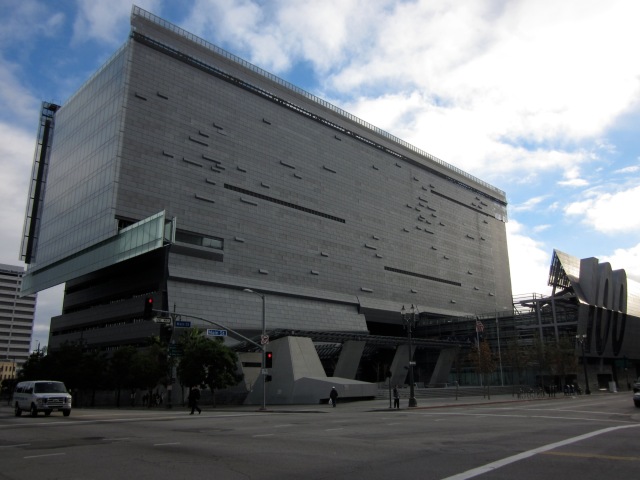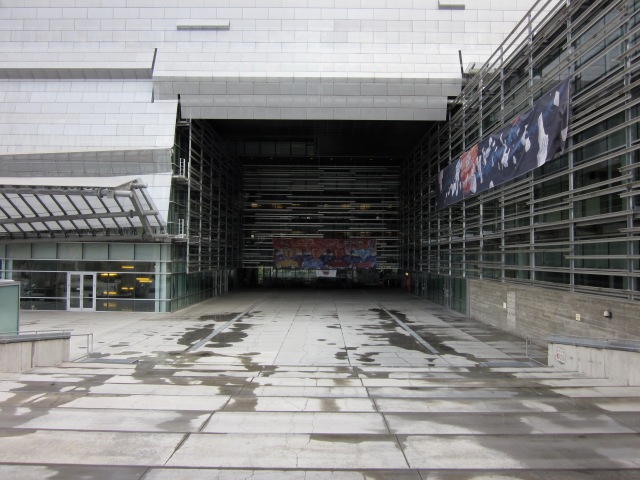Blowhard, Esq. writes:
Last weekend, I was finally able to get up close and personal to Thom Mayne’s Pritzker prize-winning (i.e. the “Nobel of architecture”) CalTrans 7 District Headquarters located across the street from City Hall in the heart of downtown L.A. To orient you, here’s an unedited Google Maps screencap:
 OK, so it’s safe to say I’m “not a fan.” Here are views approaching from different directions on Main Street. First from the north…
OK, so it’s safe to say I’m “not a fan.” Here are views approaching from different directions on Main Street. First from the north…

This site says the building is meant to “evoke a feeling of the freeways.” Two comments:
- Why the hell would you want to do that? L.A.’s freeways may be many things — marvels of construction and engineering, efficient ways (usually) to get from A to B, fantastic places for drive-by shootings — but they’re not exactly known for evoking the sort of “feeling” one wishes to dwell on. Remember the opening scene in Falling Down, how being stuck in traffic is what finally makes Michael Douglas snap?
- On the other hand, if you really want to express the soul-deadening rage and frustration that is the 405 at rush hour, this place nails it!
Alright, let’s take a closer look at this thing and hope that our sense of beauty will come out unscathed. Here’s a montage of what I call Noodle Plaza, after the metal undulating out of the concrete.
On one side of the building, some glass juts out because, gee, why not.
The blank, intimidating facade. It sorta reminds me of one of those computer punchcards from the 70s.
Let’s push in a little closer to the main entrance. [Insert inevitable joke about Death Star under construction.]
 Must be so nice to have an office view that’s obstructed by a sort of permanent scaffolding that recalls a highway guardrail.
Must be so nice to have an office view that’s obstructed by a sort of permanent scaffolding that recalls a highway guardrail.
 Turning to our left, here’s the portico. (At least I think that’s what it’s called.)
Turning to our left, here’s the portico. (At least I think that’s what it’s called.)
As you can see from this guy’s Flickr page, the rails light up at night. It’s kinda hard to tell, but I’m actually at the top of some stairs. When you go down and turn around, this is what you see.
 In his 2005 TED lecture, Mayne said the following about this building:
In his 2005 TED lecture, Mayne said the following about this building:
And now we’re seeing as the skin and the body is differentiated. Again, it’s a very, very simple notion. If you look at most buildings, what you look at is the building, the facade, and it is the building. And all of a sudden we’re kind of moving away, and we’re separating the skin from the body, and that’s going to lead to broader performance criteria, which I’m going to talk about in a minute. And you’re looking at how it drapes over and differentiates from the body. And then, again, the building itself, middle of Los Angeles, right across from City Hall. And as it moves, it takes pieces of the earth with it. It bends up. It’s part of a sign system, which was part of the kind of legacy of Los Angeles — the two-dimension, three-dimension signing, etc. And then it allows one to penetrate the work itself. It’s transparent, and it allows you to understand, I think, what is always the most interesting thing in any building, which is the actual constructional processes that make it.
(Emphasis mine.) Is that the “most interesting thing in any building” to you, the “actual constructional processes”? What about, oh I dunno, pleasure, comfort, and how it fits in with the surrounding urban fabric? But then those values serve the needs of the public as opposed to the ego of the architect, right? The emphasis on “constructional processes” strikes me as his way of saying, “Hey, look how SUPER DIFFICULT this all is. There’s no way you can do it. Aren’t I a genius?” Never mind that it has all the charm or interest of a parking garage stairwell.
 Finally, the massive, kitschy address that looms over a concrete bunker.
Finally, the massive, kitschy address that looms over a concrete bunker.
What do you think? Do you agree with the Pritzker Juror Chairman who said, “Every now and then an architect appears on the international scene, who teaches us to look at the art of architecture with fresh eyes, and whose work marks him out as a man apart in the originality and exuberance of its vocabulary, the richness and diversity of its palette, the risks undertaken with confidence and brio, the seamless fusion of art and technology.” Notice how general, unemotional, and cliched the comments of the rest of the jurors are, which include the likes of Frank Gehry and Ada Louis Huxtable.
More:
- Here’s the web site for Mayne’s Santa Monica-based firm.
- Here’s Witold Rybczynski’s thoughts from 2005 when Mayne won the Pritzker.
- Mayne is building a tower in Paris’s La Defense which is expected to be finished in 2017. Mayne said, “There’s a whole group of people that want to build new buildings that look like old buildings…It’s ridiculous, right? It would be like … somehow cherishing a horse and buggy.”
- This building serves as the backdrop to many a car commercial. This one ran ad nauseum during the Olympics.







Looks like we’re in for a new round of Brutalism.
LikeLike
Every year there should be a popular vote on which architects to ostracise, in the Greek sense.
LikeLike
Epic demoilishment.
My main thought: It’s perfectly amazing how people can talk themselves into not just “appreciating” car-crash crap like this, but into designing, financing and building it. What “stupid” drugs are they/we on?
I haven’t watched the TED talk yet. Is Mayne at least charismatic and impressive? If not, then I’m really stuck wondering how he persuades people to give him contracts …
LikeLike
I fear your reaction is what the great man intends to invoke.
LikeLike
Maybe the Pritzker should be given to the “best architectural troll” of the year.
LikeLike
Transparency opposes mystery, deflating the approach toward and entry into the building of any sense of wonder.
The soaring popularity of this kind of junk over the past 20 years just goes to show how neurotic people have become about normal human emotions. For them, the swing from anticipation through release feels like rollercoaster vertigo, so all experience must have its volatility squeezed out. We’re all just supposed to march at a uniform pace on our treadmills of joyless addiction.
Notice also how the imposing scale, empty spaces, and see-through window-walls prevent you from feeling cozy in a public space. What do people these days have against feeling cozy? It’s a return to the mid-century distrust of your fellow community members, when hardly anybody would linger in the dining room of a restaurant or take a load off in a crowded movie theater, and would only go out to eat or see a movie if they could remain locked inside the cocoon of their boat-sized car. It didn’t look so different from a hive of SUVs parked at a Sonic Drive-In.
So as much fun as it is to tear into retard architects like whoever built this mess, ultimately you must blame your fellow Americans for providing the demand for it all. It’s not just hoity-toity audiences either — the Apple Store for the middle class has floor-to-ceiling window-walls and a wide-open floor plan straight out of a mid-century ranch house. Blame the consumers for the store’s blandness and obviousness. We see transparency and “gee willickers, so that’s how they made it!” design all the way down to lowly video game consoles and controllers, the cases for pens and mechanical pencils, and other gadgets.
The entire society just feels creeped out by mystery. I wish it were only a case of space aliens foisting this junk onto an unwilling colonized population, but sadly it’s an ordinary case of supply and demand. If you don’t like what’s common in a roughly competitive market, blame the demanders rather than the suppliers.
LikeLike
I’m not sure it’s the public that demands this crap: modernism has never been popular for private homes. Most mimic some homey old example: mock Tudor, Colonial, or Tuscan.
I think it’s more a function of political dynamics. experts are appointed, and the fearful uncomprehending Council member or Mayor goes along afraid to be the philistine. Besides, New York and Boston go for this stuff, and they know what’s up right?
LikeLike
Modernism was pretty popular during the mid-century for homes, particularly on the inside. Not the norm, but more popular than during the ’20s, when the bungalow was king, or the ’80s, when front-porch gregariousness made a comeback. Off-putting houses have also become more common over the past 20 years.
Apartment buildings are even worse, both during the mid-century and past 20 years. They’re more of a communal domestic space, and that’s what really weirds people out — having to be around other people.
Modernism is all about preventing social interaction and emotional connections from taking place in public. So highly public spaces, where no one lives, get it the worst — stores, restaurants, hotels, nightclubs, office buildings, government buildings, schools, etc. Next are public-seeming living spaces like apartment buildings, and finally detached homes, which still express the anti-social zeitgeist but just not as much as the more public buildings.
It’s still a demand-side thing, just what the individuals in a certain area demand of the buildings they’ll patronize, work in, or drive by when they’re away from home.
LikeLike
This building is incredibly elegant, evocative, and dramatic. In a city of illegible, insular buildings it hangs over the street and sidewalks, changing with daylight, climate, light angles. It takes the bleak and exhausted materials we encounter all day in the suburbs – the only materials available to a government construction budget – and makes them strange and wonderful.
LikeLike
Yes!
LikeLike
Totally appropriate for L.A. It really does honour the people with an “LA Aesthetic”. But I would shoot the bastard who would try to erect it near my house or in any other place with any semblance of local beauty.
LikeLike
Punchcard!
If I recall correctly, the outdoor staircase goes up around a couple of turns and dead-ends into a blank wall. The only other staircase I’ve seen like that is in the Winchester Mystery House in San Jose.
LikeLike
I walked around it about a half-dozen years ago. My general impression was a strong sense of the architect’s hatred of the people (employees, public) who must interact with his building.
LikeLike
FWIW, Mayne’s a very ’60s guy. The theories and ideas underlying/imbuing his work are straight outta the ’60s-radical playbook.
Architects don’t generally come into their own till late in life, which explains why we’re getting swamped with a lot of crazy-’60s-inspired stuff right now.
LikeLike
Via John Massengale’s blog, here’s a quote from Mayne: “I like provoking people. It’s what you’re supposed to do.”
Sez who? Trolling is fine for message boards, not so much for urban cores.
LikeLike
Says all the people who come to see the building every year. Read more books and stop copying paragraphs from “”A Pattern language.” You might as well bow down and start worshipping the sun with such an old man stance on architecture. Keep waving that cane bro.
LikeLike
It’s a great building. Don’t be so lame and conservative.
LikeLike
>>It’s a great building. Don’t be so lame and conservative.
If it’s OK with you, I’ll be as lame and conservative as I want, thanks. And by all means, continue to enjoy the building and give yourself a good ol’ pat on the back for being progressive. We both win.
>>Says all the people who come to see the building every year.
“All the people” who visit the building every year say it’s supposed to provoke? OK. If you say so.
>>You might as well bow down and start worshipping the sun with such an old man stance on architecture. Keep waving that cane bro.
I will! Tune in here for more sun-worshipping and cane-waving!
LikeLike
“If it’s OK with you, I’ll be as lame and conservative as I want, thanks. And by all means, continue to enjoy the building and give yourself a good ol’ pat on the back for being progressive. We both win.”
Nah you lose, this whole entry is beyond dumb. Read more, seriously. Everyone benefits from intelligence, no one benefits from a lame attempt at progress.
“All the people” who visit the building every year say it’s supposed to provoke? ”
Conservative lame-oh’s are always looking for something to offend them. Less of it is needed.
LikeLike
Pingback: A Tour of the Long Beach Civic Center | Uncouth Reflections
Pingback: Linkage | Uncouth Reflections
Pingback: “Los Angeles Plays Itself” (2003) | Uncouth Reflections
Pingback: "Los Angeles Plays Itself" (2003) | Tinseltown Times
Pingback: Architecture Linkage | Uncouth Reflections
Not only do I agree that Mayne is bastardizing the LA landscape, I will never understand his razing of the Bradbury house and accusation of it as, “banal”. Banal! As if history is commonly found in LA that it is ubiquitous. He disgusts me, as does his work.
LikeLike
Fuck Thom Mayne and his shit, trendy taste.
LikeLike